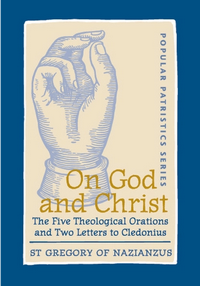 |
On God and Christ,
|

However, this illustration too was unacceptable to me. First, because it was quite clear what had set the sunbeam in motion, whereas nothing is prior to God to be his mover—he is cause of all and owns no prior cause. Second, because there is in this example a hint of those very things which are inconceivable in the case of God—composition, dispersion, and the lack of a fixed, natural stability. In a word, there is nothing to satisfy my mind when I try to illustrate the mental picture I have, except gratefully taking part of the image and discarding the rest. So, in the end, I resolved that it was best to say “goodbye” to images and shadows, deceptive and utterly inadequate as they are to express the reality. I resolved to keep close to the more truly religious view and rest content with some few words, taking the Spirit as my guide and, in his company and in partnership with him, safeguarding to the end the genuine illumination I had received from him, as I strike out a path through this world. To the best of my powers I will persuade all men to worship Father, Son, and Holy Spirit as the single Godhead and power, because to him belong all glory, honor, and might for ever and ever. Amen.
What’s On God and Christ About?
It’s all there in the subtitle, isn’t it? There are five theological orations/sermons and two letters in the book, focusing on the doctrine of the Trinity—with a focus on the person of the Son, and the “begotten” nature. According to the Introduction, these come in response to Anomean teaching—frequently referred to as Neo-Arian, but that’s not wholly accurate (and apparently would be offensive to Anomeans). The Church would formalize the response to the Anomeans in the modification to the Nicene Creed at the Council of Constantinople.
In other words—these sermons and letters are part of what laid the groundwork for that Creed that Christians confess throughout the world each week, and are a great way to come to a fuller understanding of some of what that Creed teaches. This is one of the recommended works from The Trinity: An Introduction by Scott R. Swain that I read earlier this year, and I can easily see why.
Readability and Tone
If there is one God, one supreme nature, where can I find an analogy to show you? Are you looking for one from your environment here in this world? It is a singularly graceless, and not just graceless but a pretty well futile, notion to get a picture of things heavenly from things of earth, of things fixed immutably from this transitory element. As Isaiah says, it is “seeking the living among the dead.”
For just about every reader (at least we non-scholars) the idea of reading Patristics is fairly daunting—even if you’ve done it before and emerged relatively unscathed (and maybe even learned something or enjoyed it). Dealing with a Church Father on something as technical as the Trinity? That’s beyond daunting, we’re talking intimidation now.
But there’s a reason that these sermons have lasted since the Fourth Century, they’re useful, educational, approachable, understandable. The translator calls them “as much high art as high theology,” in his introduction. Which isn’t a bad description, really.
There’s passion, there’s a hint of humor—not to make light of the topic, or to inject levity to entertain—but to serve as an aid to understanding (and to illustrate the foolishness of his opponents). This is a man who cares about what he’s talking about—this is important to him, important to his opponents, important to his audience, and therefore it must be dealt with carefully, with precision, and clearly. All of which translates well to us today.
Sure, because it’s technical Trinitarian language, it’s not the easiest thing in the world to read—but it’s not that bad. I think a careful high schooler could handle it.
So, what did I think about On God and Christ?
How has he been begotten?—I re-utter the question with loathing. God’s begetting ought to have the tribute of our reverent silence, The important point is for you to learn that he has been begotten. As to the way it happens, we shall not concede that even angels, much less you, know that. Shall I tell you the way? It is a way known only to the begetting Father and the begotten Son. Anything beyond this fact is hidden by a cloud and escapes your dull vision.
I am so glad I picked this up—what a treasure. It’s something I’m going to return to in years to come. Both for personal devotional reading as well as for help with tricky Trinitarian theology. I really think this is the kind of thing that everyone should read, and encourage you to give it a shot.

This post contains an affiliate link. If you purchase from it, I will get a small commission at no additional cost to you. As always, opinions are my own.
![]()


1 Pingback